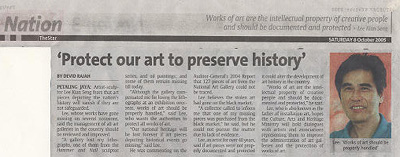
Source: The Star/ Malaysia/ Nation/ Saturday 8 October 2005

Source:
The
Star/ Malaysia/ Nation/ Saturday 8 October 2005
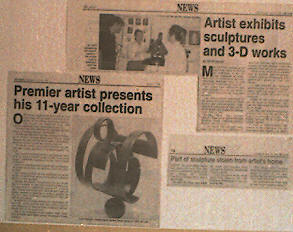
(Source: The Star , Metro, Saturday July 18, 1998)
Premier artist presents his 11-year collection
One of the country's premier artists, LEE Kian Seng, will present a collection of his works at his Klang studio-cum-gallery. The 11-year art collection from 1984 will be exhibited from tomorrow to Sep21.
Towards the New Millennium consists of nine pieces of sculptures and 3-D works.
The 50 -year artist has been praised by National Art Gallery director Datuk Syed Ahmad Jamal (himself an artist) for his immaculate craftsmanship , aesthetic sensitivity and innovative creativity.
"In all his works, Lee projects intellectual content and a high standard of professionalism," he said.
Lee started winning awards and honours soon after he entered the art scene in 1962 via a young artists' exhibition organised by the Arts Council of Malaya.
Between participating in local and international group exhibitions, he held his first solo show in 1966.The various prizes he has collected are proof of his versatility as he is just as adroit a painter as he is a lithographer.
Among the major recognitions for his works are Best Exhibit in the Arts Council of Malaysia."Young Artists" exhibition, Best artist award in the "Young Contemporary" show in 1975 and the Major awards in painting as well as graphic at the 1977 open National Competition of Painting and Printmaking.
In addition to being invited for exhibition all over the world, Lee has also been sent to represent Malaysia at international sculpture competitions and art symposiums.
One of his sculptures is the stainless steel Vision 2020 at Public Bank Bhd's Taman Wawasan in Kuala Lumpur.
***************************************************************
Source: The STAR Malaysia Wednesday July 29, 1998
Artist
exhibits sculpture and 3-D works
Malaysia’s
leading artist Lee Kian Seng is having an exhibition of his 11-year collection
of sculptures and 3-D works drew an overwhelming response since it was opened
for a preview on July 19.
Art
lovers and collectors had been pouring in to see the exhibition called Towards
the New Millennium.
Lee,
who is highly acclaimed in the genre of visual plastic art both locally and
internationally, highlighted a collection of nine pieces of 3D works and
sculptures dating from 1984 to 1995.
Among
those who visited Gallery Kian Seng were Foreign Minister Datuk Abdullah Ahmad
Badawi and his wife.
“I
am happy the minister took time off to visit my exhibition,” said Lee, who has
represented the country at international sculpture competitions and art
symposiums.
“Most
of my work is an expression of science and technology, culture, synergy of
strength, tranquillity and grace in lines and forms.
“It
also reflects the Malaysia determination in the new millennium,” said Lee,
whose work is a result of years of painstaking research.
“Some
of the sculptures took me 30 years to complete,” said Lee who has turned his
house into an art studio.
Lee,
who has won international awards, will close the preview on Sept 21 to coincide
with the end of Kuala Lumpur 98 XVI Commonwealth Games.
“I
wish to commemorate the closing of the exhibition with the Commonwealth
Games,” he said.
Photo:
Lee (left) explaining the significance of his sculpture to Abdullah and his
wife.
*************************************************************
Source: The Star Malaysia January 1 ,2000

*****************************************************
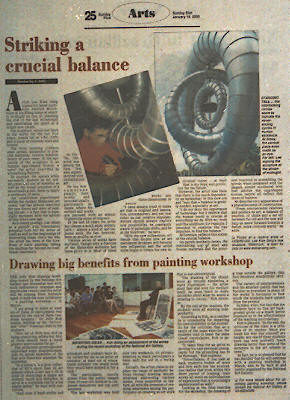
Source: Sunday Star ,Malaysia 2000 / 01 /16
Striking a crucial balance
Artist Lee Kian Seng signed his latest sculpture entitled Millennium at his Klang home at exactly midnight on Dec 31, marking the end of the last millennium and celebrating the dawn of a bright new future.
The sculpture, which has been in the works for the last five years, stands tall at 3.5m (11ft) and is made of stainless steel and bronze.
The three tapering stainless steel spirals, assembled in precise segments, revolve independent of each other. At the epicentre of the sculpture is an organic egg-shaped bronze, a motif the artist describers as symbolising Rebirth.
In contrast, the spirals while extremely modern in its construction and use of material as well as the visual sensation of a never-ending coil, seem to imply a continuity of sorts.
An established practitioner within the modern Malaysian art scene, Lee has always searched for new forms and ways of making his art - a fact that is especially pertinent with the advent of this brave new age.
As a young prodigy, Lee shone as a painter with tremendous potential both for his sense of craft as well as the beginnings of interesting ideas. Since the 60s, the artist has been at the forefront of batik painting, taking the medium far beyond its traditional constraints.
In the 70s, the artist was among the first few who experimented with Installation art.
He has won numerous awards, both locally and internationally, particularly in Japan, where his method and works are pursued with an almost frightening sense of urgency.
In the last 15 years the artist has chosen a much more solitary path - almost a kind of self-imposing exile. He has, however, been as prolific as ever.
Various series of works have surfaced, though only a fraction of the Malaysian audience has been privy to it. Most of these works are three-dimensional in nature.
"I have always tried to make art that is original and innovative, contemporary and yet that relies on our creative impulses. Artists should always explore new possibilities, be constantly aware of paradigm shifts, and be at the forefront," he says.
"With the new millennium, art trends that dictate how an art movement develops will become less influential and the artist must begin to create his own individual vision...at least that is my hope and prediction for the future."
However, the artist also feels that there is too much dependency on technology in this new era and feels that a balance is greatly needed, especially in art.
"I do not deny the importance of technology but I believe that the human touch is crucial in everything we do. With my work and this sculpture, for example, I intended to combine the two impulses, to find the balance."
Millennium reflects this notion of the crucial balance.
On purely aesthetic terms, the contrasting use of steel and bronze materials and the precision required in assembling the spirals when compared with the jagged, almost accidental trim that adorns the egg-shaped bronze centre all reflect this sense of balance.
So does the very appearance of a precariousness of construction.
"From interpersonal relations and politics to art, a balance of emotion, of ideals and a set off between the old and the new will help us move forward towards a better, more civilised world," he adds.
story by J. Anu Sunday Star ,Malaysia, January 16, 2000
*******************************************
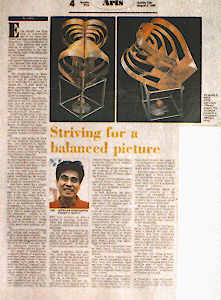
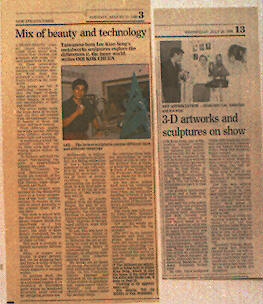
source: Sunday Star, Malaysia August 2, 1998
Striving for a balanced picture
Even though Lee Kian Seng is undoubtedly one of our more proficient and long-standing artistic innovators -- from installation to batik, from painting and print making to sculpture -- he remains, inexplicably, in the relative background of the Malaysian art movement.
And it seems to be very much a self-imposed phenomenon to distance himself from what he glibly refers to as the rampant and hugely manipulated 'politics of art'.
"Art should always be about the inner struggle of the artists, of his right to choose how his work should develop and what it should say -- it must never be about compromise and what I have found is that when you enter into the mainstream, then it is all about compromise."
And according to Lee, the moment your work is compromised then your art loses its power... "You have to be truly free to have the courage to say what you want in your art," he smiles.
Exhibiting primarily from his own home in his native Klang (Malaysia), Lee has done a series of shows -- a kind of retrospective in segments -- in the past few years.
Hence it is always gratifying to witness the next installment in the complex process of transformation.
In these new works, on show for one month at his home gallery, Lee continues to explore material in his usual manner -- without ever actually changing its basic mass or interfering with their intrinsic character.
"What I am really interested in is exploring the positive and negative aspects of a shape or form -- this principle has always been at the centre of my work."
Lee cuts away from the plane, never adding or subtracting but rather manipulating the dissected plane, turning it or bending it to reveal his intended form.
And these issues have always been at the centre of his work.
"It is a synergy I wish to impart to the work -- my philosophy of life has always been to have a world view of things, never to have a blinkered opinion for that is an uninformed opinion," he explains, "So, in my sculpture and in my handling of material, I have tried to make that the central philosophy -- adding on or cutting away is easy, but to create a form without ever losing any part of the original -- that involves much more problem solving."
And so there is a lot of folding and turning and rejoining -- all from a single sheet of metal.
In a piece like To World With Love, perhaps the central piece in this body of work, Lee uses various techniques, materials and symbols to best express himself.
Very simply, the installation or sculpture consists of a multi-layered heart-shaped sheet that has been tooled and turned. It sits on a skeletal cube made of shiny stainless steel and 'trapped' within this box is a shell made from a cast of a shell on which a bronze sphere seems to be balanced.
The sphere of course is symbolic of our world, the shell is Lee's signature icon for all life... their placing is also meant to convey specific emotions. To World With Love presents us with a myriad of meanings, both aesthetic and philosophical despite its almost simplistic way of saying things.
"Rather than reactive to the social and political climate, my work tries to be contemplative. The circle and the square for example are an integral part of Eastern philosophy... of how different elements react to each other."
Again, a premise which was very much the basic for Lee's older work like the Hammer and Nail Series which dealt with the irony of the tool becoming the victim of its function (nails were driven into the hammers -- the elements which were so linked to each other reacting with each other in a way that conveyed their painful relevance).
"I have always felt that concept must be an integral part of art but it is most difficult to say complex thing in the most simple terms and without ever threatening the aesthetic."
And Lee has always advocated the challenge of the making of the object of art, of always pushing frontiers.
In those of his sculptures composed of stainless steel sections, the attenuations, swells and curves are achieved primarily through forging.
In both instances, the metal seems to resist manipulation, the signs of the physical forces and tensions between artist and material remain the integral part of the artist's intensions.
The sculptures are then set or even skewered onto thin poles of stainless steel or beaten iron that lend a certain unbalance or even precariousness which is initially uncomfortable for the viewer -- it takes some getting used to.
"Even as early as the 70s, I remember discussing with the late Ismail Zain the issues of weight and gravity -- to make the piece as precarious as possible and yet give them a grace that allows them to stand freely."
The pedestals exceed their role as mere stands, becoming integral parts of the overall creative process.
And to see these sculptures in their state of completion, held in their vices and pedestals, dark and heavy, their seamed sections clamped together, is to see the signs of a long and intensive process of work.
The results are precise, clear, and at the same time complex. His final transformation of obdurate material implies an apparently effortless reading of surface which invades the space of the environment around it while compressing, wrapping its inner space within the turns of metal.
And slow tenuous movement is another facet of these works -- the turn of the metal as it tears away from its central mass always takes the eye on a journey through the sculpture.
This inadvertent sense of movement compels us -- the viewer -- to continually revise the space of the work for even in stillness, Lee's sculptures never presents us with a fixed view.
An experience of them is not that of a progressive discovery towards them through our perceptions but the reverse. They are, from the start, centres which generate contributions outward to our sensibilities.
The space of their viewing is never a still, empty interval, but rather a space on the move. The varying and then uniformed thicknesses of their vaguely polished metal distort reflections and the slightest motion in the vicinity of the sculptures seem to send a soft hum along the curving trajectories.
Yet their very being is never scattered or dispersed. The pieces continually turn back into themselves, wrapping around the multiple axes of their ellipses and the vitality of these pieces become immediate -- a contained and perpetual present.
'Towards the New Millennium' will run at Lee Kian Seng's private gallery till Sept 21.1998.
By J. ANU Sunday Star Malaysia August 2, 1998
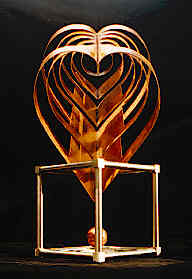
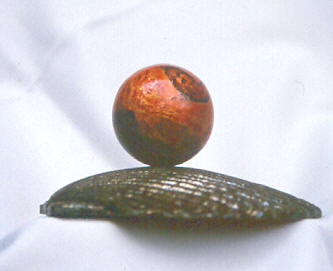 (part
detail)
(part
detail)
To World with
Love' by
Lee Kian Seng /Copper, Stainless steel, metal alloy/1985